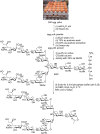Synthetic and semi-synthetic approaches to unprotected N-glycan oxazolines
- PMID: 29520306
- PMCID: PMC5827820
- DOI: 10.3762/bjoc.14.30
Synthetic and semi-synthetic approaches to unprotected N-glycan oxazolines
Abstract
N-Glycan oxazolines have found widespread use as activated donor substrates for endo-β-N-acetylglucosaminidase (ENGase) enzymes, an important application that has correspondingly stimulated interest in their production, both by total synthesis and by semi-synthesis using oligosaccharides isolated from natural sources. Amongst the many synthetic approaches reported, the majority rely on the fabrication (either by total synthesis, or semi-synthesis from locust bean gum) of a key Manβ(1-4)GlcNAc disaccharide, which can then be elaborated at the 3- and 6-positions of the mannose unit using standard glycosylation chemistry. Early approaches subsequently relied on the Lewis acid catalysed conversion of peracetylated N-glycan oligosaccharides produced in this manner into their corresponding oxazolines, followed by global deprotection. However, a key breakthrough in the field has been the development by Shoda of 2-chloro-1,3-dimethylimidazolinium chloride (DMC), and related reagents, which can direct convert an oligosaccharide with a 2-acetamido sugar at the reducing terminus directly into the corresponding oxazoline in water. Therefore, oxazoline formation can now be achieved in water as the final step of any synthetic sequence, obviating the need for any further protecting group manipulations, and simplifying synthetic strategies. As an alternative to total synthesis, significant quantities of several structurally complicated N-glycans can be isolated from natural sources, such as egg yolks and soy bean flour. Enzymatic transformations of these materials, in concert with DMC-mediated oxazoline formation as a final step, allow access to a selection of N-glycan oxazoline structures both in larger quantities and in a more expedient fashion than is achievable by total synthesis.
Keywords: DMC, ENGase; N-glycans; glycosyl oxazolines; oligosaccharides.
Figures











Similar articles
-
Rapid synthesis of N-glycan oxazolines from locust bean gum via the Lafont rearrangement.Carbohydr Res. 2019 May 15;477:11-19. doi: 10.1016/j.carres.2019.03.010. Epub 2019 Mar 23. Carbohydr Res. 2019. PMID: 30933786
-
Synthesis of N-glycan oxazolines: donors for endohexosaminidase catalysed glycosylation.Carbohydr Res. 2006 Jul 24;341(10):1574-96. doi: 10.1016/j.carres.2006.03.007. Epub 2006 Apr 11. Carbohydr Res. 2006. PMID: 16584712
-
Efficient glycosynthase mutant derived from Mucor hiemalis endo-beta-N-acetylglucosaminidase capable of transferring oligosaccharide from both sugar oxazoline and natural N-glycan.J Biol Chem. 2010 Jan 1;285(1):511-21. doi: 10.1074/jbc.M109.059832. Epub 2009 Oct 30. J Biol Chem. 2010. PMID: 19880511 Free PMC article.
-
The ENGases: versatile biocatalysts for the production of homogeneous N-linked glycopeptides and glycoproteins.Chem Soc Rev. 2017 Aug 14;46(16):5128-5146. doi: 10.1039/c6cs00897f. Chem Soc Rev. 2017. PMID: 28681051 Review.
-
Venturing beyond Donor-Controlled Glycosylation: New Perspectives toward Anomeric Selectivity.Acc Chem Res. 2018 Mar 20;51(3):628-639. doi: 10.1021/acs.accounts.7b00449. Epub 2018 Feb 22. Acc Chem Res. 2018. PMID: 29469568 Review.
Cited by
-
Protein cysteine S-glycosylation: oxidative hydrolysis of protein S-glycosidic bonds in aqueous alkaline environments.Amino Acids. 2023 Jan;55(1):61-74. doi: 10.1007/s00726-022-03208-7. Epub 2022 Dec 2. Amino Acids. 2023. PMID: 36460841 Free PMC article.
-
Site-Selective Amide Functionalization by Catalytic Azoline Engrafting.ACS Catal. 2022 Jul 1;12(13):7789-7797. doi: 10.1021/acscatal.2c01938. Epub 2022 Jun 16. ACS Catal. 2022. PMID: 37138902 Free PMC article.
-
Site-Specific Glyco-Tagging of Native Proteins for the Development of Biologicals.J Am Chem Soc. 2024 Dec 18;146(50):34452-34465. doi: 10.1021/jacs.4c11091. Epub 2024 Dec 9. J Am Chem Soc. 2024. PMID: 39653378 Free PMC article.
-
Primary Structure of Glycans by NMR Spectroscopy.Chem Rev. 2023 Feb 8;123(3):1040-1102. doi: 10.1021/acs.chemrev.2c00580. Epub 2023 Jan 9. Chem Rev. 2023. PMID: 36622423 Free PMC article. Review.
-
Chemoenzymatic Methods for the Synthesis of Glycoproteins.Chem Rev. 2018 Sep 12;118(17):8359-8413. doi: 10.1021/acs.chemrev.8b00238. Epub 2018 Aug 24. Chem Rev. 2018. PMID: 30141327 Free PMC article. Review.
References
-
- Tews I, Terwisscha van Scheltinga A C, Perrakis A, Wilson K S, Dijkstra B W. J Am Chem Soc. 1997;119:7954–7959. doi: 10.1021/ja970674i. - DOI
Publication types
LinkOut - more resources
Full Text Sources
Other Literature Sources
Research Materials
